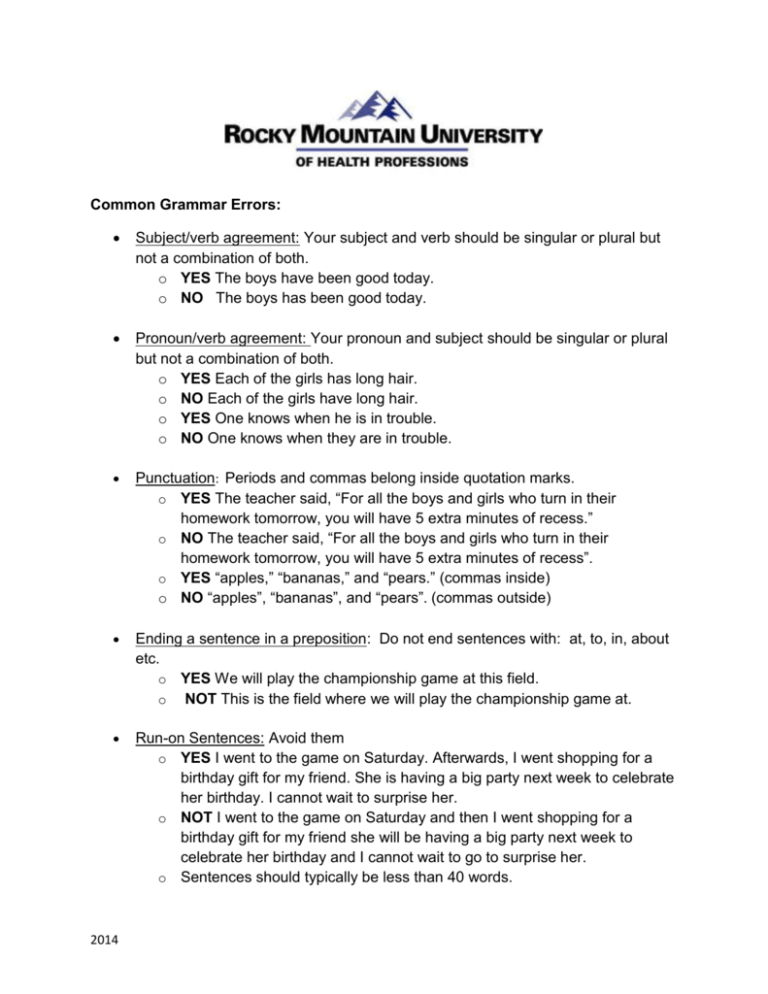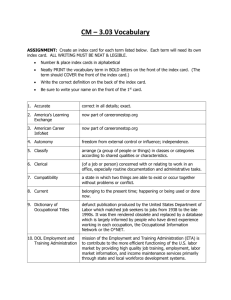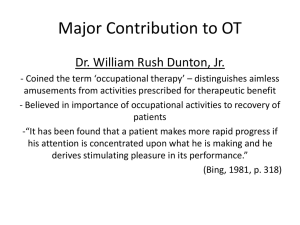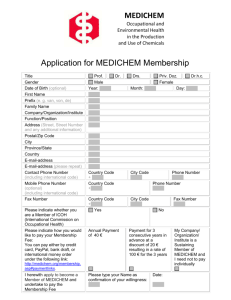Common Grammar Errors: Subject/verb agreement: Your subject
advertisement

Common Grammar Errors: Subject/verb agreement: Your subject and verb should be singular or plural but not a combination of both. o YES The boys have been good today. o NO The boys has been good today. Pronoun/verb agreement: Your pronoun and subject should be singular or plural but not a combination of both. o YES Each of the girls has long hair. o NO Each of the girls have long hair. o YES One knows when he is in trouble. o NO One knows when they are in trouble. Punctuation: Periods and commas belong inside quotation marks. o YES The teacher said, “For all the boys and girls who turn in their homework tomorrow, you will have 5 extra minutes of recess.” o NO The teacher said, “For all the boys and girls who turn in their homework tomorrow, you will have 5 extra minutes of recess”. o YES “apples,” “bananas,” and “pears.” (commas inside) o NO “apples”, “bananas”, and “pears”. (commas outside) Ending a sentence in a preposition: Do not end sentences with: at, to, in, about etc. o YES We will play the championship game at this field. o NOT This is the field where we will play the championship game at. Run-on Sentences: Avoid them o YES I went to the game on Saturday. Afterwards, I went shopping for a birthday gift for my friend. She is having a big party next week to celebrate her birthday. I cannot wait to surprise her. o NOT I went to the game on Saturday and then I went shopping for a birthday gift for my friend she will be having a big party next week to celebrate her birthday and I cannot wait to go to surprise her. o Sentences should typically be less than 40 words. 2014 Incomplete Sentences: Make sure you have a subject and verb to convey a complete thought. o YES Because I enjoy watching baseball, I do not mind sitting outside in the heat of summer. o NOT Because I enjoy watching baseball. Contractions: Avoid using contractions when writing scholarly papers. o YES I cannot wait to see the movie. o NO I can’t wait to see the movie. Plural/possessive: Use apostrophes when showing possession (exception for it is/its) o YES It is Jane’s book. o NO It is Janes book. o YES It is hers. Its cover is blue. It’s hers. (see guideline above about contractions) o NO Its mine. It’s cover is blue. Avoid the use of passive voice in scholarly writing: o YES The teacher collected the homework and granted her students an extra five minutes of recess. o NOT The homework was collected and an extra five minutes of recess was granted. Common APA Errors: Punctuation comes after the reference: o YES A baseball player has to be able to anticipate plays prior to the batter hitting the ball (Smith, 2010). o NO A baseball player has to be able to anticipate plays prior to the batter hitting the ball. (Smith, 2010) o YES Smith says, “It is best to anticipate the next move” (2010, p. 31). o NO Smith says, “It is best to anticipate the next move.” (2010, p. 31) Italicization within a reference: o YES Dirette, D., Rozich, A., & Viau, S. (2009). The issue is- Is there enough evidence for evidence-based practice in occupational therapy? American Journal of Occupational Therapy, 63(6), 782-786. (volume number, not issue number should be italicized) 2014 o NO Dirette, D., Rozich, A., & Viau, S. (2009). The issue is- Is there enough evidence for evidence-based practice in occupational therapy? American Journal of Occupational Therapy, 63(6), 782-786. (both italicized) o NO Dirette, D., Rozich, A., & Viau, S. (2009). The issue is- Is there enough evidence for evidence-based practice in occupational therapy? American Journal of Occupational Therapy, 63(6), 782-786. (neither italicized) o YES Scott, R.W. (2009). Promoting legal and ethical awareness: A primer for health professionals and patients. St. Louis, MO: MosbyElsevier, Inc. (title of book italicized) o NO Scott, R.W. (2009). Promoting legal and ethical awareness: A primer for health professionals and patients. St. Louis, MO: MosbyElsevier, Inc. (title of book not italicized) Capitalization: Always capitalize: o The R but not the h in your Running head o All letters of your title within your header o The first letter of all words in your paper title and all other titles within the text of your paper o Only the first word of journal and book titles in a reference list o The first word after a colon within journal and book titles in a reference list Titles: o The title of your paper (or an abbreviated form) should be in your running head/header o The title of your paper should be centered on the title page with the author’s name, institution, and date o The title of your paper should be centered on the first line of your first page of text (the first letter of each word should be capitalized and not in bold) Miscellaneous reminders: o The font type and size should be the same in your running head/header, title page, text, and reference page. o Always italicize and capitalize the Centennial Vision when you are referring to the official AOTA document. o Always write out the first time and use the proper abbreviation for the Occupational Therapy Practice Framework: Domain and Process, 2 nd ed (Framework-II) 2014 o The entire reference page should be double spaced without extra spaces between the title and first reference or between each reference. o If you use a direct quote, you must put quotation marks around the quote and include a page number within your parenthetical citation. o All references cited within your paper should be listed on your reference list; all references listed on your reference list should be cited within your paper. (Exception: Cite personal communications within your paper but do not list on the reference list). Online Resource: Please follow the link below for a wealth of information on scholarly writing, grammar, and APA. http://rmuohp.edu/student-resources/library-resource-center/writing-resources 2014





